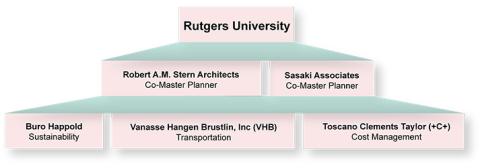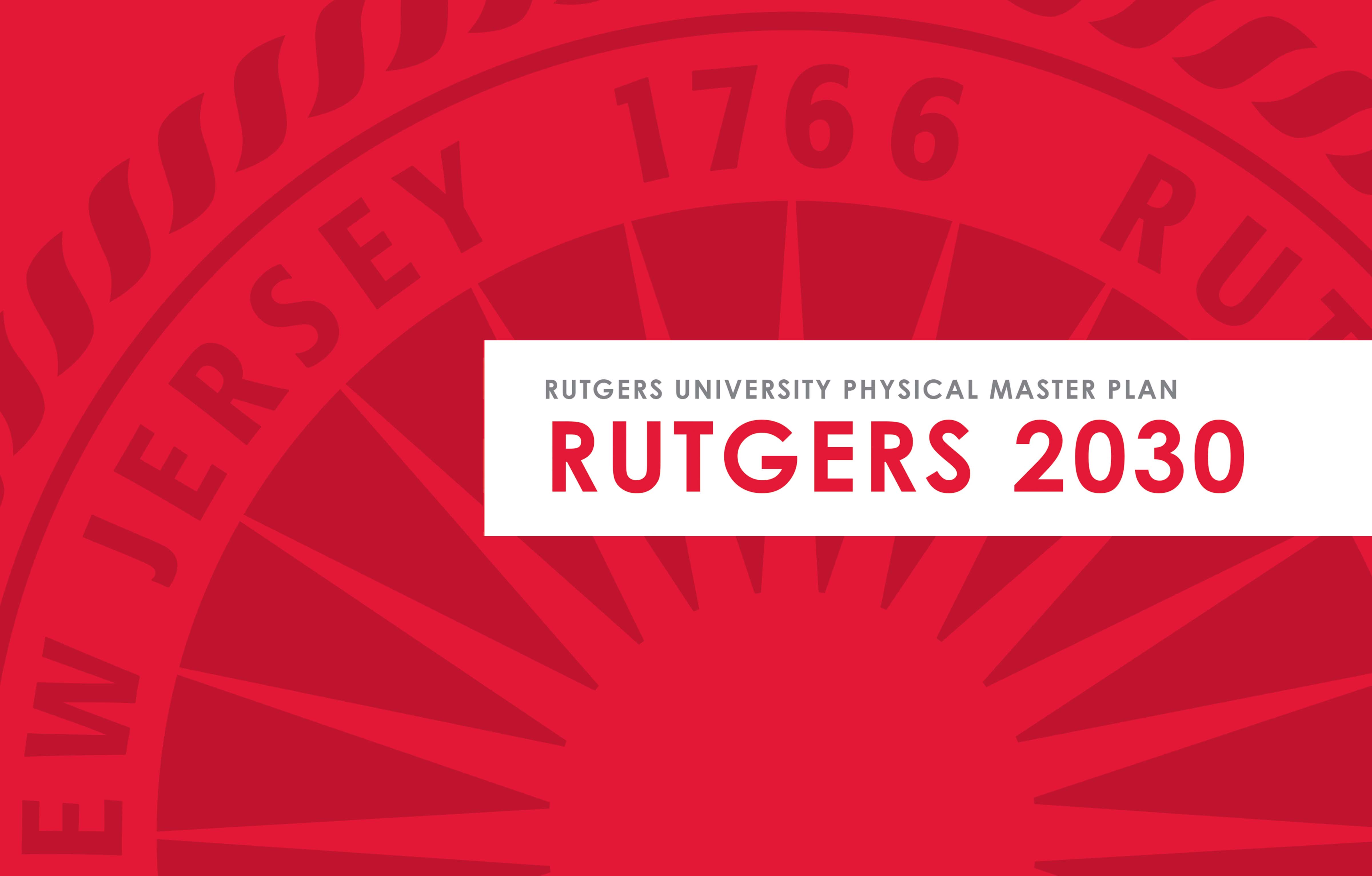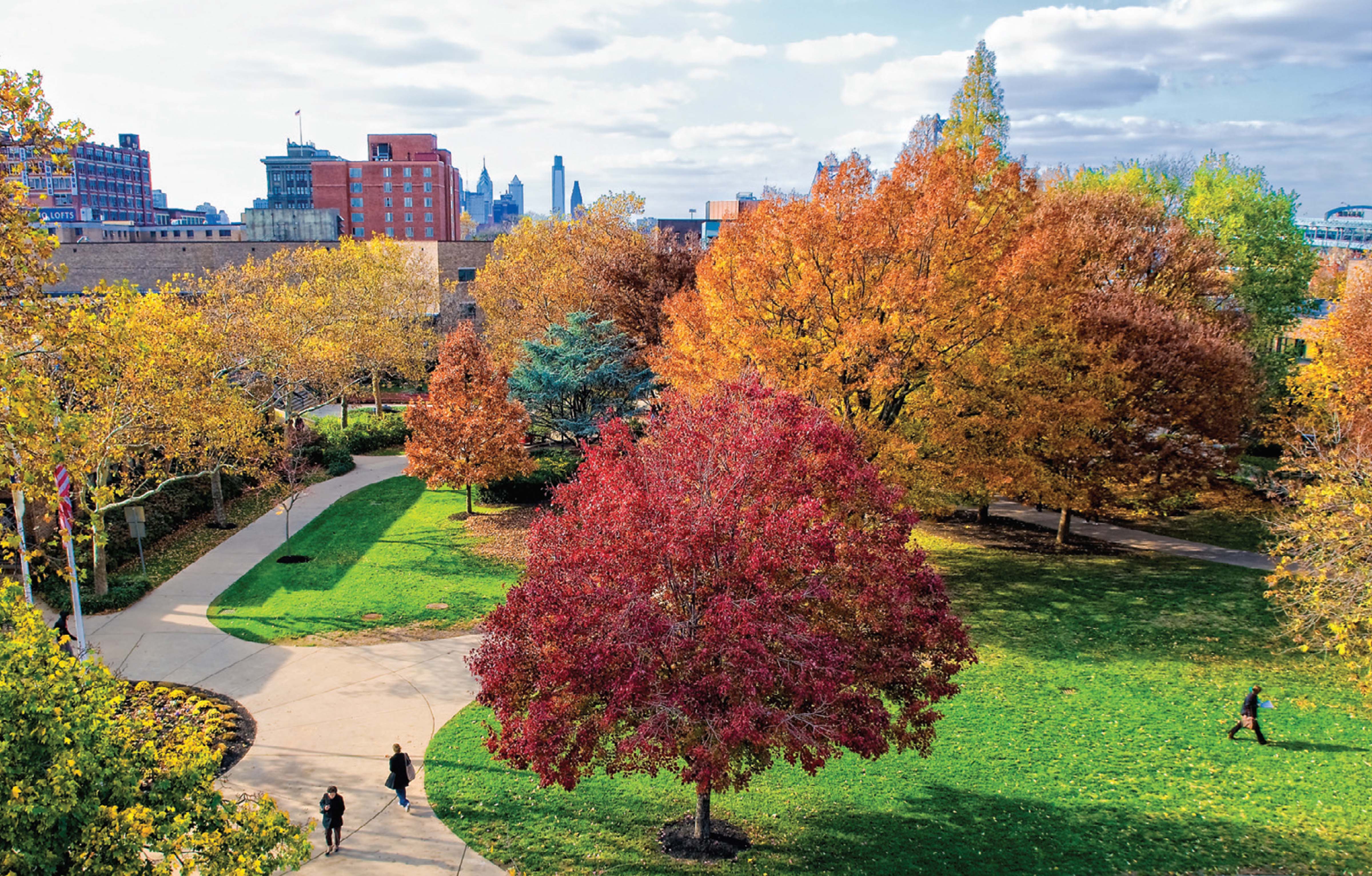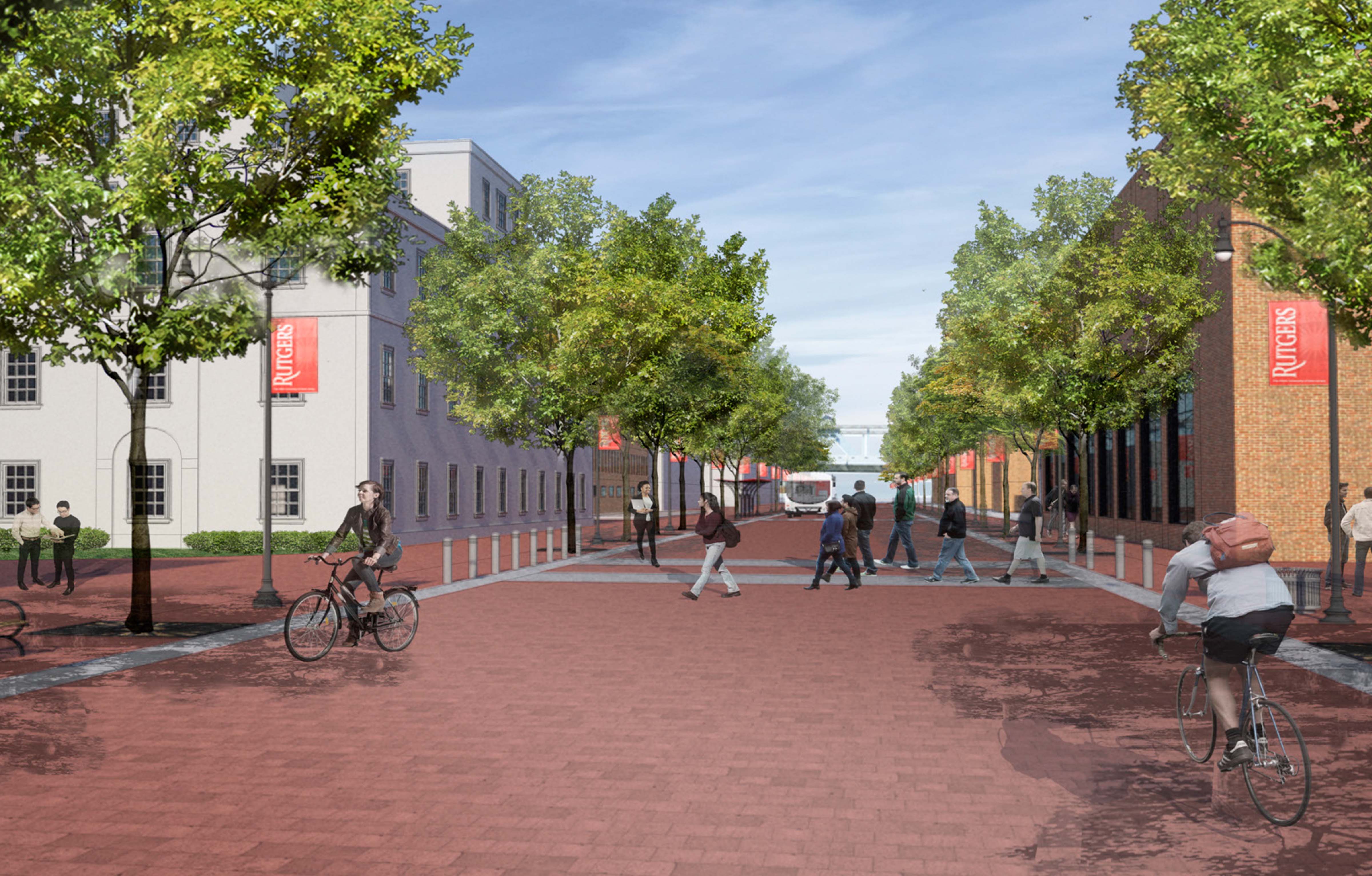Building the Future
The university physical master planning process is an important opportunity to engage the entire Rutgers community—faculty, staff, students, neighbors—in envisioning the future for its surroundings. Rutgers’ most recent physical master plan was completed in 2003; since then, the university has gone through significant growth and change. The current round of physical master planning, taking into account ongoing strategic planning efforts, will reassess each campus’s needs and goals, both individually and as part of the entire University. The physical master planning process will establish a baseline status and then produce strategies for future growth that respond to the university’s long-term goals.
These strategies, grounded in the vision and goals of the strategic plan, will guide future decision making and define paths toward implementation. Through these strategies, the physical master plan will empower a different type of thinking and process, enabling the university to carefully respond to changing circumstances, and ensuring that mission drives the development of Rutgers’ physical environment.
- About the Planning Process
-
The university physical master planning process is expected to take about a year, with completion anticipated in the spring of 2015. This is a participatory process, and your feedback will be requested at various points in each phase of the process.
- Steering Committee
-
The following group will guide the university physical master planning process on the university's behalf.
Executive Steering Committee
- Richard L. Edwards, Chancellor, Rutgers University—New Brunswick
- Phoebe A. Haddon, Chancellor, Rutgers University—Camden
- Nancy Cantor, Chancellor, Rutgers University—Newark
- Brian Strom, Chancellor, Rutgers Biomedical and Health Sciences
- Bruce C. Fehn, Senior Vice President for Administration
- Michael Gower, Senior Vice President for Finance
- Gregory Jackson, Chief of Staff
- Karen R. Stubaus, Vice President for Academic Affairs and Administration
- Felicia McGinty, Vice Chancellor for Student Affairs
- Antonio Calcado, Vice President for University Facilities and Capital Planning
- Paul Hammond, Director of Digital Initiatives
- Frank Wong, Executive Director of Facilities Planning and Development
- Master Plan Consultant Team
-
The master plan team engaged with Rutgers University’s physical master planning effort is a collaboration between Robert A.M. Stern Architects (RAMSA) and Sasaki Associates, and includes sustainability consultant Buro Happold, transportation consultant Vanasse Hangen Brustlin, and cost consultant Toscano Clements Taylor.
The RAMSA/Sasaki association is not simply a team of qualified strangers but one with over two decades of highly successful collaborations on a variety of projects involving issues similar to those facing Rutgers as it plans for the future. The two firms are currently collaborating on the campuses of the University of Nebraska and the University of Kentucky, and RAMSA has completed buildings and precinct plans within the context of master plans developed by Sasaki at the University of Michigan, Penn State University, the College of William and Mary, and Rice University.
For the Rutgers University physical master plan, RAMSA will lead the team's Master Planning, Design Guidelines, and Adaptive Re-Use phases, and will participate in the Master Planning phase in collaboration with Sasaki. Sasaki will lead the Space Programming and Space Utilization phases, which include existing conditions analysis, classroom utilization study, and benchmarking against Rutgers’ peer institutions. Together, the two firms will identify near and long-term development on the Rutgers campuses, taking into consideration student enrollment, campus and community life, and ideas of identity and a sense of place, and put in the context of physical campus environments with buildings and infrastructure, landscape, bio habitats, transportation systems, utilities and energy use, and historical significance.
The master plan effort will dovetail with the Strategic Plan and Sustainable Framework Plan in an integrated approach to planning for the future of Rutgers.
Image
ROBERT A.M. STERN ARCHITECTS (RAMSA)
Robert A.M. Stern Architects, LLP, is a 250-person firm of architects, interior designers, and supporting staff. Over its 44-year history, the firm has established an international reputation as a leading design firm with wide experience in residential, commercial, and institutional work. RAMSA maintains an attention to detail and commitment to design quality that has earned international recognition, numerous awards and citations for design excellence, including National Honor Awards of the American Institute of Architects, and a lengthening list of repeat clients.
SASAKI ASSOCIATES (SASAKI)
Sasaki is an international design firm that is actively engaged in many aspects of the built environment—architecture, civil engineering, graphic design, interior design, landscape architecture, planning and urban design, and strategic planning. Sasaki looks first and foremost to achieving the client’s goals, believing that a natural outgrowth of such a partnership is the enrichment of the public, institutional, and private realms in which we work. A purposeful cross-pollination of skills among our range of professionals results in a synthesis of economic reality, environmental sustainability, cultural awareness, and aesthetics. An emerging area of our business, Sasaki Strategies, provides strategic planning, space planning, and financial planning know-how to complement our design services with a range of innovative, real-time graphic-interface decision support systems.
VANASSE HANGEN BRUSTLIN, INC. (VHB)
VHB offers the focus and personal attention of a small consulting firm backed by the in-house resources of a 900-person, multidisciplinary company. VHB brings an integrated approach to each client and project with the requisite skills in transportation, civil engineering, environmental resource planning, community planning, and landscape architecture. By incorporating an innovative and sustainable design approach within the practice, VHB creates environments that endure.
VHB will collaborate with the master planning team on the transportation element of this project, ensuring that it supports and coordinates with the overall physical master plan. Its work will include an overall assessment of the current Rutgers University transportation system and its guiding policies, including traffic and parking, Rutgers buses, other public transit, pedestrian and bicycle connections, infrastructure, and TDM programs.
BURO HAPPOLD
Buro Happold is a team of technical experts and strategic advisers specializing in all areas of sustainable development: energy and carbon consulting, stormwater planning, infrastructure and transportation design, and ecological planning.
Buro Happold will develop a sustainability framework for Rutgers, which includes guidelines, benchmarks, and target reductions with the use of key performance indicators to support the following: campus energy consumption and demand, on-site water and solid waste treatment and reuse, sustainable transportation, ecological preservation and habitat enhancement, and microclimate enhancement. This framework document would outline a proposal for a sustainability management system that would be used as a sustainability policy and guideline for the design of Rutgers University’s physical master plan as well as on-going operations.
TOSCANO CLEMENTS TAYLOR (+C+)
Toscano Clements Taylor Cost Estimators is an independent cost-estimating and cost-management firm with numerous minority and small business certifications. With offices in New York, New Jersey, and Washington, D.C, +C+ has national experience and in-depth local knowledge across the United States, and a comprehensive and proactive approach to cost estimating and cost management with expertise across a broad range of market segments and project types.
+C+’s role on the master plan project will be to provide planning-level cost information including operating costs and planning-level anticipated construction costs for the master plan.
Rutgers 2030
Rutgers, The State University of New Jersey, embarked on Rutgers 2030 in May 2013, the first comprehensive physical master plan in over a decade and the first to incorporate Rutgers Biomedical and Health Sciences (RBHS). The physical master plan complements the Rutgers University Strategic Plan, and the chancellor-led strategic plans, which was approved by the Board of Governors in February 2014.
Rutgers 2030 envisions development at Rutgers over a 15 year time frame, 2015–2030, and is comprehensive in its scope; taking into account buildings, the natural and constructed landscape, transportation, and infrastructure. The report consists of three volumes:
The scope of input was broad, involving survey responses from approximately 8,000 members of the community, over 30 presentations and town hall meetings, and meetings with many administrative faculty, and student groups.
- Rutgers 2030 Volume 1: New Brunswick
-
The sheer size and complexity of Rutgers University–New Brunswick, equivalent in size to a small city, combined with its history as a series of independent campuses, have led to an overall lack of identity for the university as a whole.
This report offers many significant and concrete proposals for change. These proposals range from specific buildings to a broad re-thinking of the way students move around campus, as well as a new relationship between Rutgers–New Brunswick and the Raritan River, along whose banks both town and university originally grew.
In addition, the report provides a clear and strategic path forward for our Regional Biomedical and Health Sciences campuses. The RBHS Master Plan places an emphasis on interprofessional education, improves our research space, provides a more collaborative atmosphere, and elevates our medical professions while enhancing the delivery of critical care for our patients.
Table of Contents
- Rutgers 2030 Volume 2: Newark
-
Rutgers University–Newark is a remarkably diverse urban, public research university that is not just in Newark but of Newark—an anchor institution. Its location is a distinctive strength, especially in that it is a magnet for an inclusive and diverse student body and faculty, catalyzes high-impact scholarship, and presents extraordinary opportunities to collaborate with partners on metropolitan America’s greatest challenges.
View Phasing and Implementation in NewarkTable of Contents
- Rutgers 2030 Volume 3: Camden
-
Rutgers University—Camden has a well-established role as an anchor institution for the southern part of the state. Rutgers—Camden is currently home to more than 6,500 students and in recent years has undergone significant enrollment growth, which is expected to continue.
The physical master plan provides a framework to enhance the campus’s current ability to provide a first-rate educational environment for its current and growing student population while maintaining the positive attributes of an intimate campus. By reaching beyond the current physical boundaries of the current campus, this master plan enables Rutgers to be an agent of positive change in the region.
View Phasing and ImplementationTable of Contents






